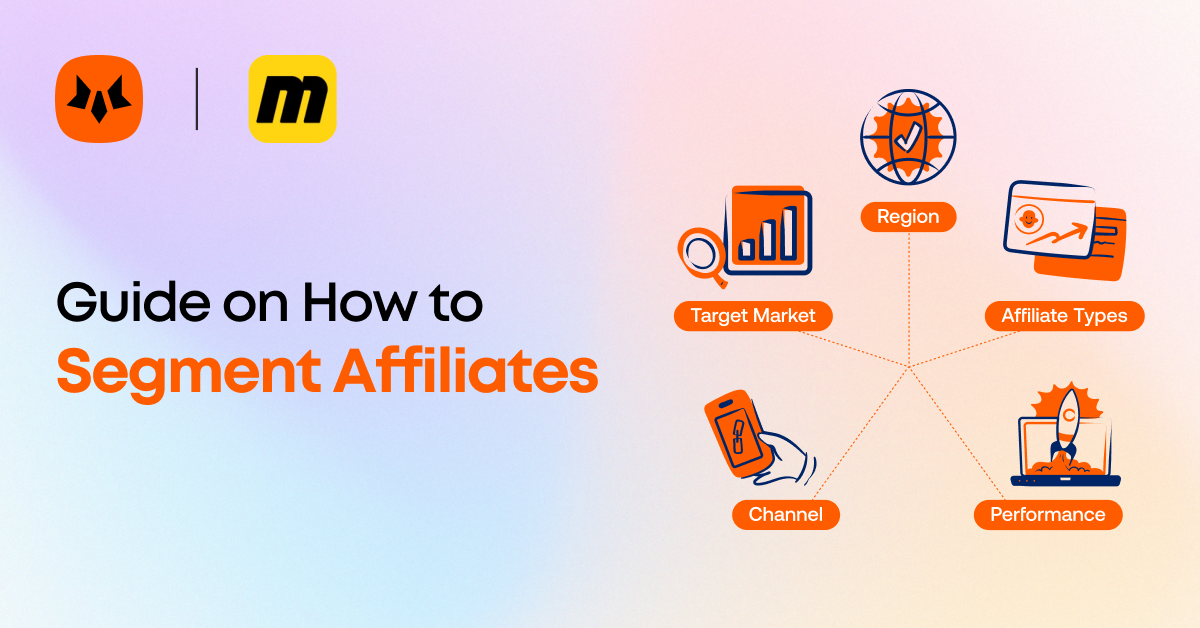Affiliate marketing continues to be a powerful strategy for scaling businesses, but its effectiveness hinges on one crucial element: segmentation.
Just as you target your customers, you must also target your affiliates. Why?
An affiliate segment is crucial in effectively targeting a specific customer segment. With tailored support and resources, affiliates can perform better and impact potential customers more.
This guide will show you how to segment affiliates effectively and uncover proven strategies for recruiting and retaining top performers.
About segmenting affiliates
What is affiliate segmentation?
Affiliate segmentation involves dividing your affiliate partners into distinct groups based on various factors. This approach helps you understand the audience better, target each group more effectively and improve your marketing efforts.
Why segment your affiliates?
- Affiliate segmentation isn’t just a buzzword; it's a critical component of a successful affiliate marketing strategy.
- Target more precisely: You can create content and campaigns tailored to each segment by grouping affiliates. It makes your marketing activities relevant and increases conversions.
- Allocate resources wisely: Focusing on high-value segments ensures that your marketing budget is spent effectively and can lead to better ROI.
- Communicate better: Understanding the needs of each segment allows you to provide the right support. This personalized communication helps build stronger relationships and keeps affiliates engaged.
- Boost performance: Custom strategies for different segments can enhance your performance. Offer tailored incentives to top-performing affiliates to increase sales.

Source: Partner Matrix
And there are vital aspects that can help you segment your affiliates effectively.
- Demographics: Segment affiliates by age, gender, or location to tailor your messages and offers.
- Interests and niche: Different affiliates focus on various niches. Align your strategies with their specific interests.
- Performance: Group affiliates by performance metrics, like sales volume, to provide targeted rewards and support.
- Marketing channels: Affiliates excel on different channels—social media, blogs, or email. Match your strategies with their preferred channels.
A quick guide to segment affiliates
Here’s a concise overview of how to segment affiliates to maximize your marketing efforts:
- Target the right audience
- Channel your efforts
- Know location
- Categorize affiliates
Let’s dive into each of these segments in detail.
Targeting the right audience
Did you know that tailoring your approach to the right audience can significantly boost your ROI and conversion rates by attracting high-quality leads?
That’s right! Targeting the right audience can help you create personalized messages to advertise to consumers who expect to see highly targeted content daily.

Source: credencys
Understanding your audience is crucial for any marketing strategy, and affiliate marketing is no exception. Segmentation begins with identifying the demographics of your target audience and partnering with affiliates who can reach them.
Identifying interests
Think of it this way - Different age groups and interests require tailored marketing approaches.
For instance, you're in the sports gear business and have 3 main age groups to cater to: kids, teens, and adults. And each segment needs different "ambassadors." Here's how you can implement the campaign.
- Kids: Engage with parent bloggers and influencers who focus on family and children’s products.
- Teens: Collaborate with affiliates who cater to youth interests, such as adventure sports or gaming.
- Adults: Partner with affiliates specializing in lifestyle, fitness, or specific sports niches.
By aligning your affiliates with the right demographic, you ensure your promotional content resonates with the intended audience, leading to higher engagement and conversion rates.

Source: Pulsar
Personalization
Personalizing resources for different segments can supercharge your affiliate outreach. For example:
- Custom landing pages: Tailor pages to match the audience type, enhancing relevance and conversions.
- Targeted promotions: Equip affiliates with banners, emails, and graphics designed for their audience segments.
- Segment-focused training: Provide training tailored to each affiliate’s platform and expertise.
- Exclusive Incentives: Customize incentives like discounts or bonuses to motivate affiliates based on performance.
For example, offering higher commission rates or unique perks to top-performing affiliates can inspire them to promote more actively.
Channeling your efforts
Affiliates often thrive on specific marketing channels. Understanding where your audience spends their time helps you allocate resources more effectively.

Source: That Random Agency
Did you know that over 80% of brands use affiliate marketing programs, but primary traffic sources come from:
- SEO: 69% of affiliate marketers incorporate SEO as a primary strategy, highlighting its significance in generating natural traffic.
- Social media: 67% of affiliates leverage platforms like Instagram, Facebook, and Twitter to connect with potential clients.
- Content marketing: 65% of affiliates utilize it, demonstrating a dedication to producing valuable content to attract audiences.
- Email marketing and PPC: Utilized by 42% and 34% of marketers, respectively.
It's all about knowing where your crowd hangs out online and then cozying up to affiliates who take charge on those platforms.
That means if your viewers are teen girls scrolling through TikTok dance challenges, then spending time wooing email bloggers won't get you far.
Matching marketing channels to your market's vibe means bigger wins – like "serving up their favorite snack on a silver platter".
Knowing the location
As Common Sense Advisory reported, 72.4% of consumers are more likely to buy a product with information in their language.
Moreover, a study from McKinsey & Company revealed that cultural integration strategies can help businesses increase their revenues by up to 30% compared to those that use a one-size-fits-all strategy.
The metrics above indicated that geographical segmentation can enhance your marketing efforts by addressing regional preferences and languages. Same to working with affiliates:
- Language: Customize your outreach materials based on the language preferences of your target audience. For example, English ads may work well in the USA, but you might need Japanese translations for affiliates targeting Japan.
- Cultural preferences: Adjust your marketing messages to align with local customs and cultural norms.
- Time zones: Schedule your communications and promotions according to the local time zones of your affiliates to maximize engagement.
By addressing these factors, you can build stronger relationships with your affiliates and improve engagement.
Categorizing the affiliates
Everyone loves a good deal, right?
With affiliate marketing, segmentation based on engagement levels and performance can help you tailor your rewards and recognition strategies.

Source: Phonexa
Consider categorizing your affiliates based on the following:
- Purchase frequency: Reward affiliates who generate frequent sales with special bonuses or higher commissions.
- Advocacy: Recognize affiliates who actively promote your brand and drive word-of-mouth referrals.
- Content quality: Value affiliates who create high-quality, engaging content that resonates with your audience.
Here's why:
- A study by Bain & Company found that increasing customer retention rates by 5% can lead to a profit increase of 25% to 95%. With that in mind, rewarding affiliates who drive frequent sales with bonuses or higher commissions can motivate them to sustain their performance.
- Nielsen reports that 92% of consumers trust recommendations from people they know. Recognizing affiliates who advocate for your brand and drive referrals can amplify your brand’s reach. So, make sure businesses acknowledge their efforts, making affiliates promote more enthusiastically.
- According to the Content Marketing Institute, high-quality, engaging content can result in 6 times higher conversion rates than generic content. Valuing affiliates who produce top-notch content ensures that your brand is best highlighted.
Implementing a structured rewards program based on these categories can incentivize affiliates to maintain high performance and loyalty.
4 simple ways to recruit affiliates
Recruiting affiliates is a crucial step to scaling your affiliate marketing program. Here's how to segment affiliates effectively and attract the best partners, especially if you're new to affiliate marketing.

Source: Monster claw
Offer they can't resist
How do you segment affiliates so ideal that they don’t stop mailing you?
Start by crafting an offer that stands out.
You've probably heard of these hotshots: High commissions, exclusive discounts, and killer bonuses that will have affiliates running to join faster.
These call-to-actions can be powerful motivators. For beginners in affiliate marketing, focus on straightforward value propositions, such as a 10-20% commission rate, which is standard across many successful affiliate programs.
This strategy ensures that affiliates feel rewarded for their efforts, making it easier for you to attract quality partners within your niche.
Spread the word far and wide
Now that you've got an offer hot enough to melt the hottest hotcakes. Let them shout out.

Source: Emmet Gibney
Networking is vital in affiliate marketing, especially when starting. Tap into your existing connections, including your customers, social media followers, and professional contacts, to find potential affiliates.
Tools like an electronic business card make it easier to share contact details instantly and professionally—especially during virtual meetings or quick online interactions. These can complement LinkedIn profiles, Calendly links, or personalized affiliate media kits.
Encouraging your current audience to participate can give your affiliate marketing program a solid foundation.
Use platforms like LinkedIn or Facebook groups dedicated to your niche to target affiliate marketing efforts more effectively. Slide into those DMs with a pitch that packs a punch, and light up social media with your unbeatable opportunity.
Find the best fit
It's all about quality over quantity!
Around 87% of the customers purchased after seeing their favorite influencer promoting a product.
When learning how to start affiliate marketing, one essential step is to identify affiliates that align with your niche and values. Look for influencers, bloggers, or content creators who already appeal to your target audience.
For example, if your affiliate marketing niche is health and wellness, seek out fitness bloggers or nutrition influencers whose followers are interested in your products. This approach ensures you’re recruiting affiliates naturally aligned with your brand.
Ensure engagement and motivation
Regularly promote your affiliate marketing opportunities across multiple channels to keep your affiliate program visible.
Use email marketing, social media posts, and even blog content to spread the word. For beginners, start by creating easy-to-follow guides on how to segment affiliates, outlining the benefits of your program. Consistent communication attracts new affiliates and keeps your existing partners engaged and motivated.
Once affiliates join, keeping them engaged is essential. Regular communication, support, and recognition can significantly boost their performance.
- Regular Updates: Share new promotions and tips to keep affiliates informed.
- Recognition: Reward top performers with bonuses or shout-outs.
- Open Communication: Keep lines open through newsletters and direct messages for support and feedback.
- Personalized Support: Offer resources tailored to affiliates’ needs, helping beginners and advanced partners alike.
Enhancing your affiliate marketing with Shopify
Shopify offers powerful tools to boost your affiliate marketing by allowing you to segment and manage your affiliates effectively. If you’re running a Shopify affiliate program, segmenting affiliates can help you target specific groups with personalized incentives, track performance, and maximize your ROI.
📚 You may also like:
- 6 Steps to Create a Successful Shopify Affiliate Program for Your Store
-
How To Start Affiliate Marketing With No Money: Shopify Affiliate D2C Guide
Using Shopify affiliate apps

Source: Shopify App Store
Shopify’s ecosystem includes apps that simplify affiliate management and segmentation. Here’s how they can help:
- UpPromote: This is a comprehensive affiliate management app for Shopify. It makes setting up, managing, and optimizing your affiliate program effortless. With features like custom affiliate links, automatic tracking, and detailed performance analytics, it becomes easy to categorize affiliates by their activity levels.
- AiTrillion: Positioned as the ultimate marketing solution for Shopify stores, AiTrillion enhances customer engagement and retention. It integrates various marketing strategies such as email, SMS, web notifications, pop-ups, and loyalty rewards programs into one platform.
- Refersion: Specializing in tracking sales and categorizing affiliates by performance, Refersion assists in segmenting affiliates effectively. By evaluating metrics like sales volume or click-through rates, it enables the provision of personalized rewards, thus enhancing targeted affiliate marketing strategies on Shopify.
Implementing these ttools in your affiliate segmentation strategy
To get the most out of your Shopify affiliate marketing efforts, it's important to utilize these apps to their full potential. By integrating these tools, you can:
- Automate tracking and reporting: Save time and reduce manual errors with automated tracking.
- Analyze performance for better segmentation: Use the data from these apps to identify trends and segment your affiliates by performance, marketing channels, or engagement levels.
- Optimize communication: Customize your communication and support based on affiliate segments.
By integrating these tools into your Shopify affiliate program, you can make segmentation easier and use targeted strategies that lead to improved results. With Shopify and the appropriate affiliate apps, you'll notice enhanced performance, engagement, and return on investment from your affiliate marketing campaigns.
🎁 Expert Tip & Gift:
- Enhance your Shopify affiliates program with UpPromote - 20% OFF
- Engage customers using Affiliate, Loyalty Rewards Program, and more by AiTrillion - 20% OFF
Bottom Line
Implementing affiliates is a key strategy for improving your affiliate marketing. By sorting affiliates into groups based on their audience, channels, where they are located, and how well they perform, you can create more effective strategies. This helps increase engagement and leads to more successful outcomes.
By using Shopify's affiliate marketing apps, managing and organizing your affiliates becomes straightforward. You can also provide each affiliate group with customized resources and special promotions that are more likely to appeal to them.
Segmenting your affiliates not only increases your return on investment but also strengthens your relationships with them. This lays the groundwork for a lasting and successful partnership.






